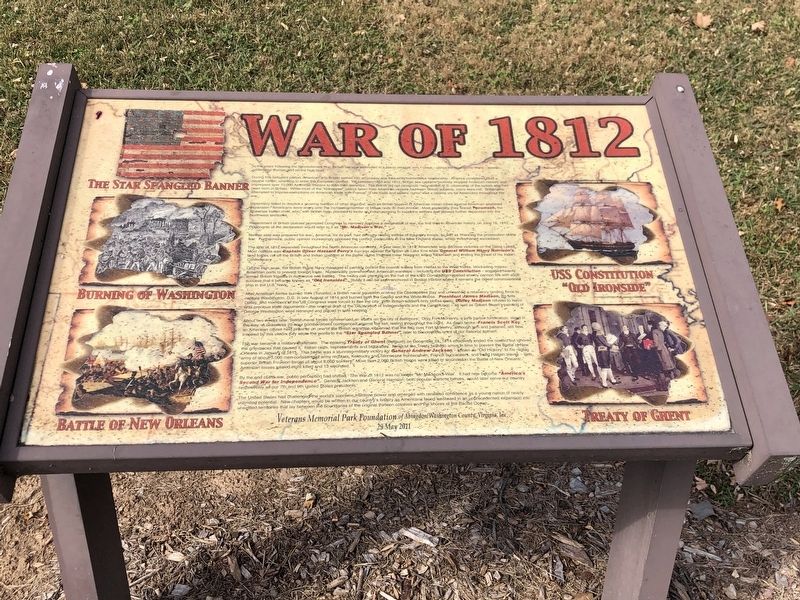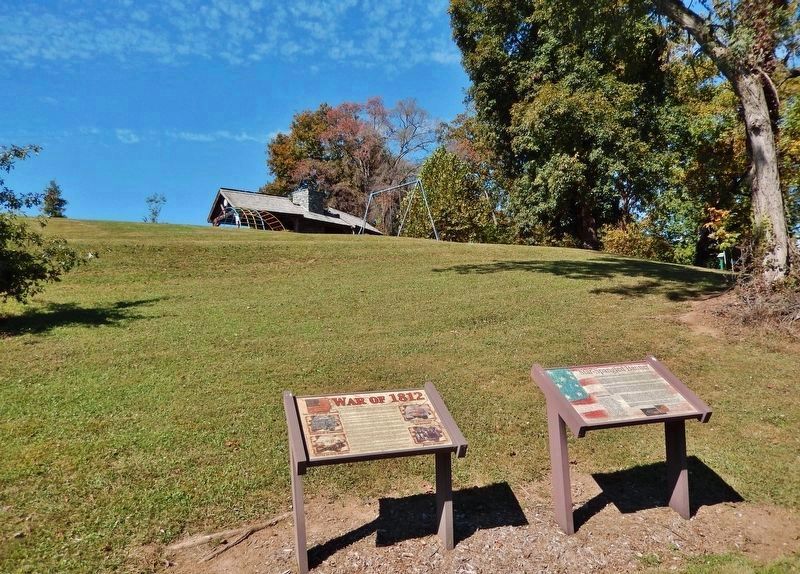Abingdon in Washington County, Virginia — The American South (Mid-Atlantic)
War of 1812
During this turbulent period, American and Britain settled into an uneasy and frequently contentious relationship. America considered itself a neutral nation, unwilling to enter the European conflict. Yet between 1803 and 1812, British sea captains routinely stopped American vessels and impressed over 10,000 American citizens to man their warships. The British did not recognize “naturalized” U.S. citizenship of the sailors who had been born in Britain. While most of the “kidnapped” sailors taken from American vessels had been British subjects, many were not. Britain also attempted to impose restrictions on American trade with France. “Free trade and sailors' rights” was a rallying cry for Americans throughout the war.
Diplomacy failed to resolve a growing number of other disputes, such as British support of American Indian tribes against American westward expansion. Americans were angry over the increasing number of Indian raids on their frontier. Most especially, they feared Tecumseh, the Shawnee Indian chief, who, with British help, planned to incite an Indian uprising to expel the settlers and prevent further expansion into the Northwest territories.
Resentment of British policies prompted Congress to narrowly approve a declaration of war, the first time in American history, on June 18, 1812. Opponents of the declaration would refer to it as “Mr. Madison's War.”
Neither side was prepared for war. America, for its part, had difficulty raising militias of voluntary troops, as well as financing the prosecution of the war. Furthermore, public opinion increasingly opposed the conflict, particularly in the New England states, which threatened succession.
The War of 1812 expanded throughout the North American continent. A year later, in 1813, Americans wop decisive victories on the Great Lakes. Most notable was Captain Oliver Hazzard Perry's success against the British on Lake Erie while General William Henry Harrison's land forces cut off the British and Indian coalition at the Battle of the Thames (near Niagara), killing Tacumseh and ending the threat of his Indian Confederacy.
On the high seas, the British Royal Navy managed to partially control the coastal waters from Halifax to the West Indies, blockading major American ports to prevent foreign trade. Numerically overwhelmed, American warships - including the USS Constitution – engaged armed British frigates in numerous sea battles. The heavy oak planking on the hull of the USS Constitution
repelled enemy cannon fire with such success that it became known as “Old Ironsides”. Today it can be seen anchored in Boston Harbor where it remains the oldest commissioned ship in the U.S. Navy.
After American forces burned York (Toronto), a British naval squadron entered the Chesapeake Bay and unleashed a retaliatory landing force to capture Washington, D.C. in late August of 1814 and burned both the Capítol and the White House. President James Madison, his wife Dolley, and members of the US Congress were forced to flee the city. With British soldiers only blocks away, Dolley Madison refused to leave until precious state documents – the original draft of the Déclaration of Independence and the Constitution – as well as Gilbert Stuart's painting of George Washington were retrieved and placed in safe keeping.
About two weeks later, British naval forces commenced an attack on the city of Baltimore: Only Fort McHenry, a lone harbor fortification, stood in the way. A ceaseless 25-hour bombardment commenced against the fort, lasting throughout the night. As dawn broke, Francis Scott Key, an American citizen held prisoner on one of the British warships, observed that the flag over Fort McHenry, although tern and battered, still flew. Inspired by this vision Key wrote the words to the “Star Spangled Banner”, later to become the lyrics of our national anthem.
The war became a military stalemate. The ensuing Treaty of Ghent (Belgium) on December 24, 1814 effectively ended the conflict but ignored the grievances that caused it: Indian raids, impressments and blockades. News of the Treaty failed to arrive in time to prevent the Battle of New Orleans in January of 1815. This battle was a stunning military victory for General Andrew Jackson – known as “Old Hickory” to his ragtag army of about 3,000 men-consisting of army regulars, Kentucky and Tennessee frontiersmen, French buccaneers, and freed Haitain slaves – over superior British invasion forces of about 8,000 soldiers. More than 2,000 British troops were killed or wounded in the Battle of New Orleans – American losses totaled eight killed and 13 wounded.
By the end of the war, public perception had shifted. The War of 1812 was no longer “Mr. Madison's War”. It had new become “America's Second War for Independence”. General Jackson and General Harrison, both popular wartime heroes, would later serve our country respectively as our 7th and 9th United States presidents.
The United States had challenged the world's supreme maritime power and emerged with renewed confidence as a young nation of nearly unlimited potential. New chapters would be written in our country's history as Americans faced westward in an unprecedented expansion into unsettled territories that lay between the boundaries of the original thirteen colonies and the shores of the Pacific Ocean.
Erected 2011 by Veterans Park Memorial Foundation.
Topics. This historical marker is listed in this topic list: War of 1812. A significant historical month for this entry is January 1815.
Location. 36° 42.28′ N, 81° 58.516′ W. Marker is in Abingdon, Virginia, in Washington County. Marker can be reached from Lt Billy Webb Avenue, 0.1 miles north of Cook Street. Marker is in Veterans Memorial Park. Touch for map. Marker is at or near this postal address: 425 Lt Billy Webb Ave, Abingdon VA 24210, United States of America. Touch for directions.
Other nearby markers. At least 8 other markers are within walking distance of this marker. Star-Spangled Banner (here, next to this marker); Lewis & Clark Expedition (here, next to this marker); Purple Heart (here, next to this marker); Pvt. Michael Widener (a few steps from this marker); Spirit of 1776 (within shouting distance of this marker); Overmountain Men (within shouting distance of this marker); U.S.-Mexican War (within shouting distance of this marker); Medal of Honor (within shouting distance of this marker). Touch for a list and map of all markers in Abingdon.
Credits. This page was last revised on February 2, 2023. It was originally submitted on November 10, 2022, by Duane and Tracy Marsteller of Murfreesboro, Tennessee. This page has been viewed 88 times since then and 12 times this year. Photos: 1. submitted on November 10, 2022, by Duane and Tracy Marsteller of Murfreesboro, Tennessee. 2. submitted on November 14, 2022, by Cosmos Mariner of Cape Canaveral, Florida.

